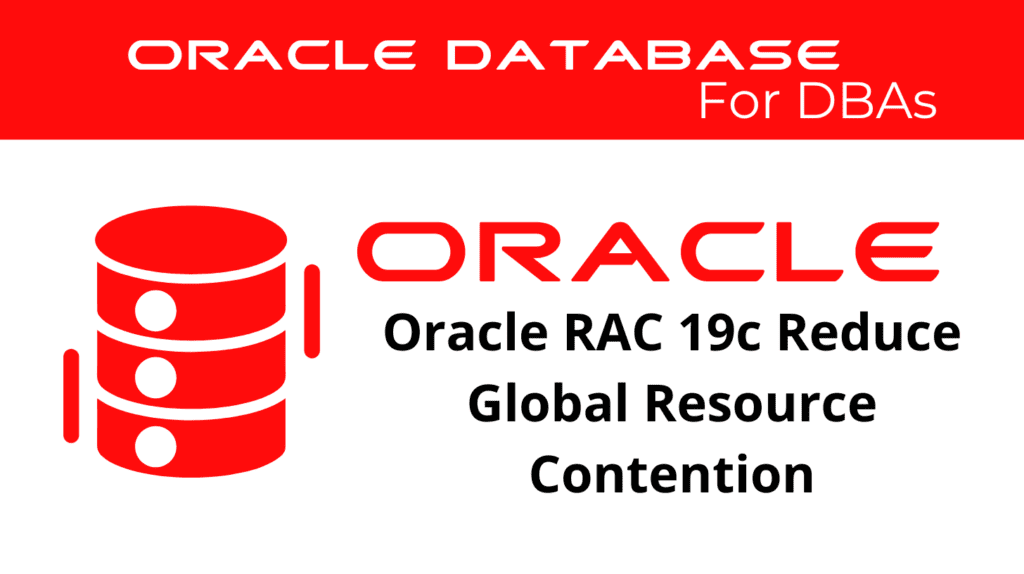
In this article, we will explore Oracle RAC 19c and how resource affinity is used to reduce global resource contention. Rsc affinity and resource contention are crucial for maintaining performance and efficiency in a clustered environment like Oracle RAC. This tutorial provides a comprehensive understanding of these concepts within Oracle RAC 19c.
Understanding Resource Affinity
Resource affinity, or affinity management, is a key aspect of Oracle RAC 19c. Efficiently managing rsc affinity ensures that database processes run on the nodes where their needed resources are located. This reduces the need for inter-node communication, improving performance.
Benefits of Resource Affinity: Implementing rsc affinity in Oracle RAC helps reduce latency and enhance throughput. By ensuring that related processes and data stay on the same node, Oracle RAC minimizes the overhead linked to resource contention.
Example1: Configuring Resource Affinity:
ALTER SYSTEM SET instance_groups='group1';
ALTER SYSTEM SET service_names='service1' SCOPE=BOTH SID='instance1';
This configuration assigns a service to a specific instance, enhancing rsc affinity.
Tools for Managing Resource Affinity: Oracle RAC provides several tools for managing rsc affinity, such as Oracle Clusterware and Oracle Enterprise Manager. These tools help administrators optimize resource allocation and improve system performance.
Preparing for Resource Affinity Management
Before implementing rsc affinity, it is essential to configure the necessary settings and understand the environment.
1. Configuring Init Parameters: Ensure that the initialization parameters related to rsc affinity are properly configured.
ALTER SYSTEM SET resource_affinity=TRUE SCOPE=BOTH;
2. Monitoring Resource Usage: Regularly monitor resource usage to identify potential contention and optimize performance.
Example2: Monitoring Resource Usage:
SELECT instance_number, value
FROM gv$sysmetric
WHERE metric_name = 'Current OS Load';
This query provides details about the current load on each instance, indicating resource usage patterns.
📢 You might also like: Oracle 19c Identify RAC-specific Tuning Components (Category: RAC and GRID)
Techniques to Reduce Resource Contention
Resource contention, or lower contention, plays a vital role in Oracle RAC 19c. Managing the allocation and usage of resources prevents conflicts and ensures smooth database operations. Oracle RAC uses sophisticated algorithms to manage resource contention effectively.
Reducing Resource Contention: Oracle RAC 19c provides several techniques to reduce resource contention, such as configuring resource plans and using dynamic workload management. These techniques help ensure that resources are allocated efficiently and that contention is minimized.
Example3: Using Resource Plans:
BEGIN
DBMS_RESOURCE_MANAGER.CREATE_PENDING_AREA();
DBMS_RESOURCE_MANAGER.CREATE_SIMPLE_PLAN(
plan => 'reduce_contention_plan',
comment => 'Plan to reduce resource contention',
cpu_mgmt => DBMS_RESOURCE_MANAGER.CPU_MANAGED
);
DBMS_RESOURCE_MANAGER.SUBMIT_PENDING_AREA();
END;
/
Resource Affinity – This code creates a resource plan designed to reduce contention by managing CPU allocation.
Managing Resource Efficiency: Effective lower contention involves monitoring resource usage, identifying contention hotspots, and reallocating resources as needed. Tools like Oracle Enterprise Manager and GV$ views aid in this process.
Example1: Identifying Contention Hotspots:
SELECT session_id, blocking_session
FROM gv$session
WHERE blocking_session IS NOT NULL;
This query identifies sessions that are blocked due to resource contention.
Implementing Resource Affinity and Contention Management in Oracle RAC
To manage resource affinity and reduce contention effectively, Oracle RAC 19c utilizes several tools and techniques. These include monitoring resource usage, configuring system parameters, and using Oracle Enterprise Manager for real-time insights.
Step-by-Step Implementation:
- Configuring System Parameters: Adjust system parameters to optimize resource affinity and reduce contention.
ALTER SYSTEM SET resource_affinity=TRUE SCOPE=BOTH;
ALTER SYSTEM SET instance_groups='group1' SCOPE=BOTH;
- Monitoring Resource Statistics: Regularly monitor system statistics to identify issues and optimize performance.
Example2: Monitoring Resource Statistics:
SELECT instance_number, name, value
FROM gv$sysstat
WHERE name IN ('logons current', 'active sessions');
- Using Oracle Enterprise Manager: Utilize Oracle Enterprise Manager for comprehensive monitoring and management.
Example3: Viewing Resource Affinity in OEM: Navigate to the “Performance” tab, then select “Resource Affinity” to view detailed information about current resource allocation and potential issues.
- Adjusting Resource Allocation: Adjust resource allocation based on monitoring results and advisory recommendations.
Example1: Adjusting Resource Allocation:
ALTER SYSTEM SET service_names='service1' SCOPE=BOTH SID='instance1';
Benefits of Effective Resource Affinity and Contention Management
Effective resource affinity and contention management, including affinity management and lower contention, offer numerous benefits in an Oracle RAC environment. Firstly, it improves overall system performance by ensuring efficient resource allocation. Secondly, it enhances data consistency and integrity by minimizing contention. Lastly, effective management facilitates easier troubleshooting and resolution of issues.
Performance Improvement: Improving performance is one of the main benefits of effective resource affinity and contention management. By optimizing resource allocation and reducing contention, Oracle RAC 19c ensures smooth and efficient database operations.
Enhanced Stability: Improving stability is another key benefit. By managing rsc affinity and reducing contention effectively, Oracle RAC 19c reduces the risk of system crashes and data corruption. This results in a more stable and reliable database environment.
Scalability: Scalability is crucial for growing businesses. With effective rsc affinity and contention management, Oracle RAC 19c can easily scale to handle increased workloads. By ensuring efficient resource allocation and usage, the system can accommodate more users and higher transaction volumes without compromising performance.
Conclusion
In summary, managing rsc affinity and reducing resource contention in Oracle RAC 19c is a complex but essential task. By understanding and implementing effective resource affinity and contention management techniques, administrators can ensure optimal performance and stability of their Oracle RAC systems. The key to success lies in continuously monitoring, adjusting, and optimizing resource usage to meet the demands of the database system.
See more on Oracle’s website!
Be Oracle RAC and GRID Certified Professional, this world is full of opportunities for qualified DBAs!





